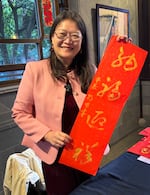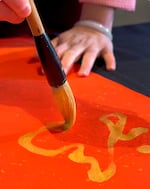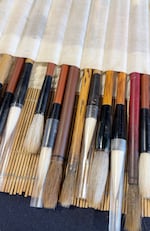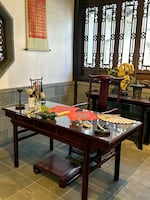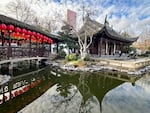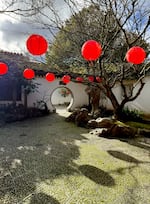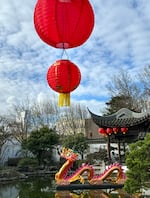Saturday is the first day of the Year of the Dragon, the beginning of the Lunar New Year celebrated around the world. In Oregon, Lan Su Garden in central Portland has many festivities planned.
Venus Sun, the garden’s vice president of culture and community, said the events will go through March 2 and include 20 nights of lantern viewings.
“We are going to have nonstop activity here during the full month of Lunar New Year celebration,” Sun said. “You’re going to see lion dances, martial art performances.”
To celebrate the start of the Year of the Dragon on Saturday, Lan Su will host a free, and open-to-the-public, traditional lion dance performance at Lan Su’s entrance.
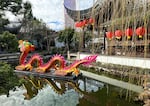
“We are going to have nonstop activity here during the full month of Lunar New Year celebration,” Venus Sun, Lan Su's vice president of culture and community. “You’re going to see lion dances, martial art performances.” Feb. 10 marks the beginning of the Year of the Dragon.
Lillian Karabaic / OPB
Lan Su is a walled garden in the heart of Portland’s Chinatown. Outside the garden, you hear the typical sounds of a city: car traffic, train horns. But take just a few steps through the garden’s round gate, and the urban din fades under the waterfall’s roar, gentle tinkle of rain on the clay roof tiles, and birds chirping.
Instead of the city’s grit, visitors are treated to koi swimming around the pond, stone paths, and a serene teahouse, built in the style of a Suzhou scholar garden.
The spring festival will even bring artisans from Suzhou, Portland’s sister city, to Lan Su to show their silk embroidery and “Nianhua” Lunar New Year woodblock prints. Venus Sun said the artisans’ visit is “a rare opportunity to see Grand Masters at work. "
One of the other traditional artists taking up residency at the garden is calligrapher Terri Hsing, but she modestly wouldn’t describe herself as an artist.
“Some people call me an artist, but I just call myself an art worker,” she said. She’ll be doing live demonstrations on Saturday and Sunday.
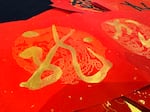
Traditional Chinese calligraphy, created to celebrate the Lunar New Year, featuring the character for "dragon."
Lillian Karabaic / OPB
Hsing has called Vancouver, Washington, home for 20 years, but first learned calligraphy as a child in Taiwan. Her talent for it meant she was placed in a special school for artistic children and continued to study it in college.
Hsing said that calligraphy spring couplets are very common in communities in Taiwan and mainland China to celebrate the new year, but she doesn’t see them here as much. She enjoys sharing the tradition with people in the Pacific Northwest, in both her practice and as a teacher.
While in town, she works out of Lan Su’s scholar’s study, an ornately decorated building in the northeast corner of the garden. Lan Su modeled this room after the studies where upper-class men would practice calligraphy and study for China’s challenging imperial exam. The exam traces its roots back to the Sui dynasty in the sixth century. A civil service version of the exam still exists today.
Related: Chinese traditions bloom at Portland’s Lan Su Garden’s Chrysanthemum Festival
Hsing practices with the same type of brush used by scholars over 1,800 years ago. It’s a fat brush made with animal hair — a mix of lamb and weasel hair — with about 2 inches of bristles and a thick wooden handle.
Hsing dips the brush into shimmering gold ink, special for the new year, and delicately twists the bristles to draw characters on the red paper. It looks like a ballerina doing a pirouette. She writes in the regular cursive style that originated in the Han dynasty around 202 B.C. This fast and fluid writing showcases the writer’s unique artistic expression.
While it takes her just a few seconds to draw each character, she says that’s only because she has decades of training. While a professional calligrapher might only show up for “five or 10 minutes,” said Hsing, it only looks easy and natural because “we practice for 5 or 10 years.”
Her couplets contain stories by laying out the characters to form new shapes. They might invite wealth, happiness, or romance into the new year. Fish is a common theme for Lunar New Year couplets, symbolizing abundance. The red paper is used for Lunar New Year, like the red lanterns that decorate Lan Su.
The use of red dates back to an oral tradition that the “Nian” New Year monster is afraid of the color red and fire. People shield themselves from danger by scaring off the Nian beast with red paper and fireworks.
Related: Ushering in the Year of the Rabbit
Hsing’s work just ahead of the Lan Su event included two red rice paper banners, each about 3 feet, 6 inches long. They are meant to be hung side by side in a doorway for Lunar New Year, to scare off Nian. Together they read “Auspicious Dragon Presents Blessings for a Safe Year.”
Terri Hsing and other artisans of Chinese traditional crafts will show off their talents as Lan Su Garden as part of the Spring Festival. They are celebrating the Year of the Dragon with cultural performances, lantern viewings, and artist demonstrations through March 2.
Information and tickets are available at lansugarden.org

